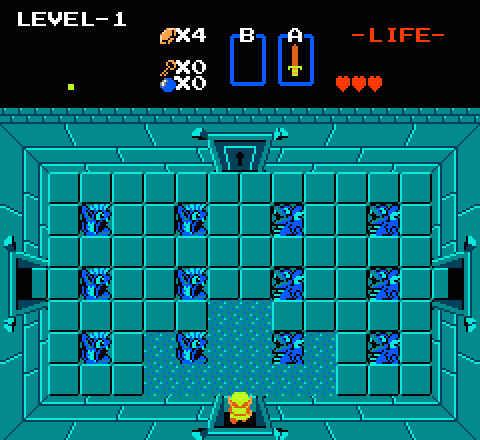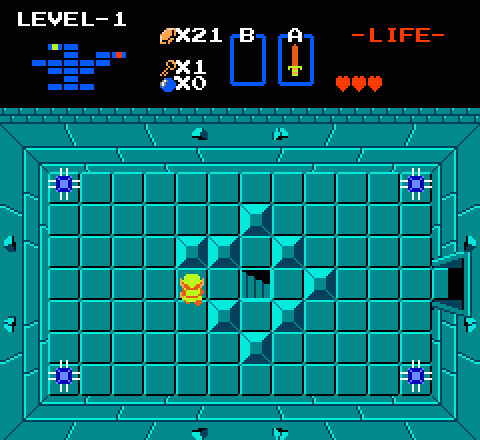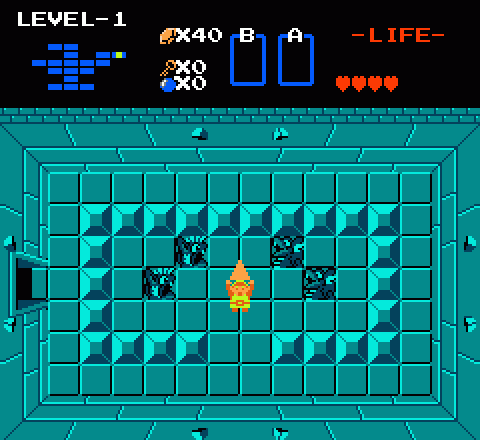You would think that, as a baby-easy cakewalk, The Legend of Zelda‘s first dungeon would merit very little discussion. But you’d be wrong! The game treats this level as training wheels for much of what is to come; the dungeon navigation tricks you learn here, where the challenge level remains gentle, will guide you through much of the remainder of the quest.
Right here at the very beginning of the first dungeon, you see Zelda playing with that “up equals forward” expectation. The entrance echoes the opening screen of the game, with doors into the dungeon leading west, north, and east, but the northward door is locked. Chances are good you probably don’t have a key; unlike later games, keys aren’t finite resources but rather are available for purchase at many shops around the world. However, this early in the game, the likelihood that you’ll have sunk precious cash into a key is pretty slim. So, unless you have very strange consumer priorities, your first step into the Eagle dungeon will see your northward progress thwarted by that locked door, forcing you to duck left or right instead.
Now, if Brick Road’s notes on dungeon theory are to be believed, 70% of all people go right when faced with this sort of decision. As a member of the other 30%, my instincts are in line with those of Zelda‘s designers: Both the rooms to the east and the west will net you a key, but the room to the west (left) feels more like the first room you’re meant to explore as the enemies within are extremely weak and simple to defeat. To the right, you’ll encounter an army of skeletons, which hit a little harder and take two hits to destroy rather than one. On the other hand, you can actually see the key in the skeleton room, as it’s being carried (visibly) by one of the monsters. This communicates both the fact that the tool you need to continue is contained here, and that destroying enemies will sometimes earn you valuable equipment.
Either way, the key you earn for your efforts allows you to go north. You only have to clear one room right now, but the dungeon has exactly enough keys to grant access to its locked doors, so at some point you’ll need to empty out the other room as well. And so we learn the value of thoroughness.
The first room to the north contains monsters but no key, which teaches you that not all rooms contain treasure. You can only go up from here, but in doing so you’ll reach a room with no exit to the north. Those 70 percenters will find more skeletons and a new dungeon tool: The compass, which reveals the dungeon’s ultimate destination on the mini-map in the top console panel.
The compass is wholly optional, though. You can easily complete the dungeon without it. The path forward is actually to the left, though it winds back around to the right after leading you one room to the north. This room contains your first switch puzzle, though I hesitate to call it a a puzzle because it’s utterly simplistic. The door to the west is shuttered by a door that contains no keyhole. The only feature in the room is a single raised block. Pressing against the block momentarily will cause it to shift one space, tripping the lock and causing the shutter to open in the process.
Interestingly, this puzzle is wholly optional. If you don’t figure it out, you can still complete the dungeon. The shuttered room contains nothing of any real value, besides a chance to learn a fundamental skill you’ll need throughout the adventure. The difference between this Zelda and a modern one is that the shutter appears on the left (leading to a non-critical dead-end chamber) rather than the right; in a contemporary title, it would be reversed, and some sort of chatty AI companion would draw attention to the switch as the camera panned and zoomed on the features.
HEY! THE DOOR IS LOCKED. I WONDER IF YOU COULD OPEN IT BY PUSHING THAT BLOCK?
Neither approach is inherently correct, but I think a mix of the two would be ideal: Place the switch puzzle in the critical path, but don’t nag the player about it. Trust in their problem-solving skills. We’re not morons, game developers!
What you will find along the critical path, however, is the dungeon map. The map causes a full display of the dungeon layout to appear in the command console at the top of the screen. Unlike the compass, the map can be utterly essential for solving many of the later dungeons, so the Eagle labyrinth makes the thing practically impossible to miss.
Here the game makes another unusual decision about optional content. The Eagle dungeon gets its name from the fact that its layout roughly resembles the silhouette of a bird, and it places the boss and Triforce fragment in the eastmost “wing” of the labyrinth. The head can be completely skipped, should you so choose — and you might, if you grabbed the compass and noticed that your objective is due east.
But you should go up, because it contains an essential tool for completing the game: The bow. You literally cannot complete Zelda without the bow, because it’s the key to beating two bosses… including Ganon himself. Nevertheless, you can completely skip it here if you choose (or if you muddle past unawares).
The room design in this discretionary (but not really) annex introduces the most complex elements yet. One room includes non-traversable spaces, forcing Link to maneuver along narrow paths. Another introduces Goriyas, boomerang-throwing foes (the first of many enemies you’ll meet in a dungeon who can fire projectiles). And finally is the room pictured above, in which you’ll spot a seemingly inaccessible staircase hidden within a diamond of blocks. Did you figure out the shutter puzzle a few rooms back? If so, you’ll probably make the intuitive leap to push different blocks until one moves. Naturally, the one that opens up the path to the stairs is opposite the entrance, forcing players to outwit the razor traps that slide along the wall when you come between two of them.
Your reward is a path underground presented in what appears to be a side-on perspective. Inside, you’ll find the bow… but no arrows. Unless you bought arrows at a merchant — possible, since you might not have realized that you’d also need a bow and assumed you were acquiring the full set right out of the gate — this item is useless. Still, it’s essential in the end, and I’m not entirely enthusiastic about the designers’ decision to make it so optional.
A second sub-weapon appears in Eagle, and it too is optional (though less like to be missed): The boomerang. Kill a team of Goriyas along the critical path to acquire the wooden boomerang, which is one of the few instances of a game of this vintage giving the impression of looting corpses to claim the enemy’s own equipment.
Finally, the last room before the boss contains nothing but a key and a set of Wall Masters, hand-like creatures that emerge from the walls and grab Link, dropping him at the entrance to the dungeon. This room is actually rather clever! Wall Masters only materialize when Link stands adjacent to a wall, and the designers placed the key along the south wall. You’ll be tempted to make a beeline for the key, leaving yourself vulnerable to be snagged by a Wall Master. Still, this isn’t completely unbroadcast: A Wall Master emerges from the wall when you first set foot into the room, so you can deduce something is up before it all goes horribly wrong.
Eventually, you’ll fight the boss, Aquamentis. It’s a green unicorn dragon that spits a three-bolt spread of fire that even an upgraded shield can’t block. The wait time between blasts leaves you plenty of time to dart in, stab the creature, and duck back out safely.
With Aquamentis down, you can claim the Triforce fragment hidden here. That’s important for completing the game. However, the most important thing you gain from Eagle is a strong understanding of how Zelda‘s dungeons work. The subsequent underground areas will throw in their share of new twists, but the fundamentals are all right here. Like Indy said, the real treasure was knowledge.






I think they should have switched the position of the Boomerang and Bow.
Not too long ago Miyamoto actually brought up all the hand holding in recent Zeldas. I honestly hope that’s a sign they’re ready to back off that. I mean, this article is a perfect example of how you can do the *same thing* with clever design rather than constant nagging. It’s sad that they once knew how to do this so well and have lost their way in that regard.
The game I associate most with that kind of handholding is Metroid Prime 2. After the first game’s great design, it was a shock to start up MP2 and find every room introduced with a camera zoom toward the solution of the room’s obstacles, as if the camera was operated by a Gamefaqs walkthrough. It mostly happened in the opening area, thankfully, but it was still obnoxious.
@Warlock I don’t know if it’s a matter of them losing their way so much as them growing utterly terrified of alienating even a fraction of their audience (read: consumer base) by expecting them to make it through a game on their own steam. Success begets timidity.
It was always pretty odd how you found the bow in a dungeon and had to buy an arrow to use it, moreso because arrows aren’t drops and your shots were depleted from your money. A bow that converts Rupees into arrows…Sounds like it would’ve been a great Malo Mart product.
The boomerang, especially its magical upgrade, is by far the tool I use the most when playing The Legend of Zelda and the more 2D oriented installments. It’s great for crowd control in most non-Darknut non-Wizzrobe situations, and especially for bat extermination, keeping a woken Armos in place to stab it up, holding Like Likes at bay, and keeping track of that one killable ghost on a graveyard screen when ghost grinding.
Aquamentus is a piece of cake for the first boss, especially if you have full hearts so you can laser sword him to death and ESPECIALLY especially if you’ve collected a couple of heart containers and the White Sword by knowledge of replay or FAQ. It’s a pity that unicorn dragon hasn’t shown up in any more modern Zeldas like Gohmas and Dodongos have. Aside from Oracle of Seasons that is, which had analogues for all the Zelda 1 bosses.
Neat little trick for the first dungeon:
The first locked door (to the north) when you enter the dungeon will become unlocked if you leave the dungeon and then re enter.
THAT IS CRAZY what the hell
I miss Aquamentus… and useful boomerangs. They just weren’t the same after the series went 3D… (except in later 2D installments, perhaps).
I really need to get Oracle of Seasons… come on, Nintendo! Bring it to the eShop already!
JParish: It’s a shame they seem so terrified about it. Really, though, they’ve created their own solution in things such as the Super Guide; just set it so that it offers the hint based on a timer, rather than the second you step in the room, with an option to ignore it.
And I guess if people have trouble actually pulling off what needs to be done, perhaps implement an actual Super Guide feature.
Even thinking about the roar of a boss monster bellowing from a nearby dungeon room in LoZ gives me the willies to this day.
Oh yeah, the roars were awesome.
I’m not sure the “optional” nature of the bow is so bad. The completionist in my always wanted to explore every room on the map when I found it. But I guess everyone isn’t that OCD. Either way, knowing there were unexplored rooms meant that you might have missed something. SO when you hit a wall, you could go back and tie up loose ends to see if you needed something to advance the game.
Also, great articles! I really loved the Castlevania one as well.
You are truly enjoying this anatomy of a game, I assume. Nevertheless, are you going to tackle those fickle changes and adjustments between the japanese version and the version all westeners enjoyed and remember fondly?
Zelda always feels like that park you learned to enjoyed, I’ve always felt that the Zelda franchise from the beginning of every entry, the designers would take you by the hand and show you how to get started.
As a left handed handed guy, I’ve always enjoyed the rewards by going against the scripted path for everybody else. but I’ve never read someone put in words that understanding, I never though that there could be a scripted path for left oriented choices.
The same seems to happen with recent Super Mario games.
Thanks. I doubt I’ll get into the Japanese-to-English revisions since most of those are minor tweaks that have little bearing on the actual instructional and mechanical design of the game.